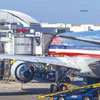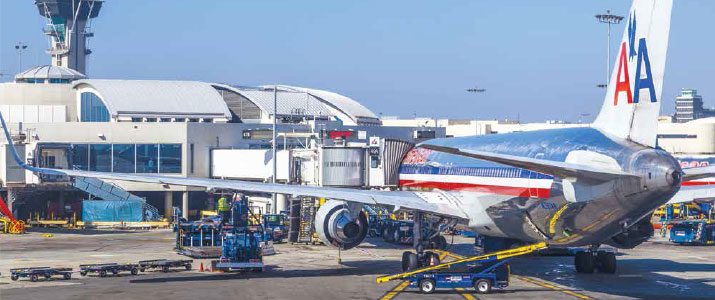
LAX Gets It
New stakeholders take surveillance technology to new heights
- By Anthony Incorvati
- Jul 01, 2013
 Earlier this year when discussing the state of the surveillance industry,
Axis Communications’ North American General Manager Fredrik
Nilsson was quoted as saying that some historically all-analog vertical
markets have completely shifted their focus from “Why IP?”
to “Which IP?” This apt sound-bite was re-quoted, re-used and retweeted
by a number of people throughout the industry.
Earlier this year when discussing the state of the surveillance industry,
Axis Communications’ North American General Manager Fredrik
Nilsson was quoted as saying that some historically all-analog vertical
markets have completely shifted their focus from “Why IP?”
to “Which IP?” This apt sound-bite was re-quoted, re-used and retweeted
by a number of people throughout the industry.
The story behind the quote originated in an internal discussion about the transportation
market, specifically airports, railways and ports. With hundred- to thousand-
camera systems covering vast areas and disparate facilities—coupled with
the security department’s need to have high-quality video at their fingertips at all
times—today’s network video solutions are the only logical and cost-effective choice.
This IP shift has had a ripple effect on the sales and installation process in
the transportation surveillance market. With these massive IP-connected systems
being installed across an entire organization, new surveillance stakeholders are
emerging at the planning table, creating a team of decision-making experts.
It’s no longer the security department making the majority of the decisions. And,
since we’re moving to all-IP technology, the IT department is heavily involved.
The new security installation at Los Angeles International Airport (LAX) epitomizes
this IT trend and is a model example for the industry to follow.
The Future of Flight
LAX is the sixth-busiest airport in the world—third in the United States—and is
operated by Los Angeles World Airports (LAWA). In 2011, the airport served more
than 61 million passengers and today runs upwards of 600 flights daily through almost
75 air carriers. The cargo shipped alone per year is valued at around $85 billion.
According to LAX, the airport is undergoing a $4.11 billion capital improvement
program that covers everything from new high-tech gates to receive latestgeneration
aircraft to upgraded retail and restaurant outlets. Enhanced security is
a major part of this investment.
LAX’s existing security systems did not meet the need of law enforcement and operational
staff, was technologically obsolete and, maybe most importantly from an
operations perspective, were a burden to support, said Dominic Nessi, deputy executive
director/chief information officer for LAWA. Therefore since 2010, LAX has been
replacing three of its most critical applications to improve its physical security posture:
expanded video surveillance, upgraded access control and a new badging system.
One of LAWA’s main goals with the security upgrade was to provide public
safety, operations and maintenance with systems and technology that could be upgraded
as needed to help them manage the entire airport efficiently and effectively.
This is where the scalability benefits of IP video played a major role.
Captain, Co-pilot and the Entire Crew
But before LAWA made any technology decisions regarding the new security system,
it did an extensive review to set proper expectations about wants, needs, musthaves,
desires and goals. Included in these discussions were the airport director and
all of the deputies representing the major operational groups at LAX.
Since the surveillance, access control and badge systems are supported by the
IT group, they led the discussion and needs analysis—a trend seen across all markets
for large installs as technology shifts to IP. Nessi and his team presented the IT
perspective so that airport infrastructure, maintenance needs, storage, bandwidth
and usage were all considered in the final decisions.
With Unisys as LAWA’s technical security advisor and assistance from the consultant
firm Ross & Baruzzini, who works closely with LAWA’s Information Technology Project Management Office, LAX
chose Axis Communications network
cameras recording to Hewlett-Packard
servers and HID Global readers for access
control, which are all managed by a
NICE Systems video management system
(VMS).
Reaching New Heights with IP
LAX’s original surveillance system included
more than 800 analog cameras
recording to tape drives that were no
longer being manufactured. Over the
years the airport accumulated five disparate
systems that eventually were
made up of obsolete hardware and
software. Yet, what was worse was the
time and effort it took security and IT
staff to locate, extract and share video
evidence for investigative purposes
when needed.
For LAX to tie together all these
systems under one umbrella, the first
step was to migrate the technology to a
digital footprint controlled by NICE’s
VMS and replace all storage devices
with HP servers, which was a crucial
step for laying the groundwork for today’s
video system that grew from 800
to 1,000 cameras to today’s 3,000-plus
camera system.
Moving to IP allows for this type of
scalability. Now if LAX needs to add a
single IP camera to cover a new checkpoint
or 200 cameras to monitor a new
mezzanine, it is simple for Nessi’s team
to open an Ethernet port or wireless
connection to the camera, which then is
instantly tied into the NICE System to
enable security staff, operations managers
and law enforcement to perform
a number of tasks.
For instance, NICE Inform can stitch
together video from different cameras
throughout the airport to follow a potential
suspect or help parents find a lost
child. NICE Situator allows operators
to enter information like date, specific
time or—with help from the high quality
video of the IP cameras—specific pixel
detail to pinpoint an incident like a stolen
bag or checkpoint infraction.
Nessi also appreciates the mobility
of the new system, as video can be sent
securely to anyone who needs it. If the
security team is searching for a suspect,
a recorded video clip or single snapshot
can be sent to their mobile devices in
the field. If someone from operations
wants to see how traffic flow is handled
at the security checkpoint during a specific
time of day, the video can be sent
to their desktop to be analyzed.
Quality Video,
Quick Maintenance
While scalability, ease of use, instant
video search and the ability to easily
share with system users are all favorite
features of LAX’s new surveillance system,
video quality is equally important.
After all, as the saying goes: garbage in,
garbage out.
LAX selected a mix of fixed, fixed
dome and PTZ Axis network cameras
to complete the most recent phase that
brought the total camera count to more
than 3,000. The image quality was a
night-and-day comparison to the airport’s
grainy analog cameras, and especially
impressive with the HDTV-compliant
cameras used in and outside of LAX.
In fact, video quality is proving to
be as important for additional users as it is for the security department.
“Network video’s flexibility, along
with today’s HDTV image quality, is allowing
for many more users of the system,
well beyond the traditional security
subscribers,” Nessi said. “The move
to IP video has made it easier for our
risk management, operations and maintenance
departments to become large
consumers of LAX’s video system.”
The IP cameras selected also work
in tandem with the VMS intelligence
to improve maintenance. Nessi’s team
is well-trained on troubleshooting and
maintenance issues, but the IP system
makes their jobs more efficient.
For instance, instead of troubleshooting
devices on the security network
one at a time, blanket firmware
upgrades can be made from the central
station to update the cameras with the
latest features. Additionally, tampering
alarms can be used to alert security
staff if a camera is disconnected from
the network, turned to face another direction
or even if it goes out of focus.
It does this by learning the pixels in the
scene and sending an alert if those pixels
change dramatically.
With the VMS and IP cameras providing
increased intelligence, proactive
alerts help the entire LAX team implement
smarter surveillance and find
uses for the video they hadn’t considered
before.
The New Face(s) of
Airport Installation
For large-scale surveillance systems like
the ongoing project at LAX, the decision
process must be a team effort. Because
numerous departments at LAX share
the video system, all inputs continue to
be extremely valuable to get the most
out of a versatile IP-connected system.
IT departments like Nessi’s are especially
important to driving the project
from idea to completion in today’s security
market because they can act as
a coordinating point for many different
uses and combine the perspective of the
entire organization. For example, while
the security department remains a critical
source of information on best practices,
camera features and access control
needs, required field of views and
potential threat areas, the IT department’s
knowledge is invaluable when it
comes down to the bits and bytes of the
finished product.
What used to be a typical CCTV
system of a few hundred analog cameras
found in airports around the
world has morphed into systems comprising
thousands of intelligent IP
video devices. It is equivalent to connecting
3,000 more computers—that
can see extremely well—to a network.
If procured the right way with the adequate
amount of research, IT departments
should be able to treat security
devices, storage arrays and service
requests just as they would any other
node on their network.
By leading with Nessi’s IT team,
LAX and LAWA are on to something
big that provides a great blueprint for
airports around the world looking to
upgrade their critical surveillance and
security systems.
This article originally appeared in the July 2013 issue of Security Today.